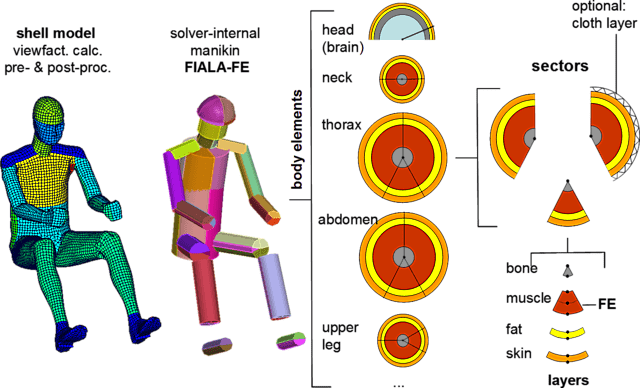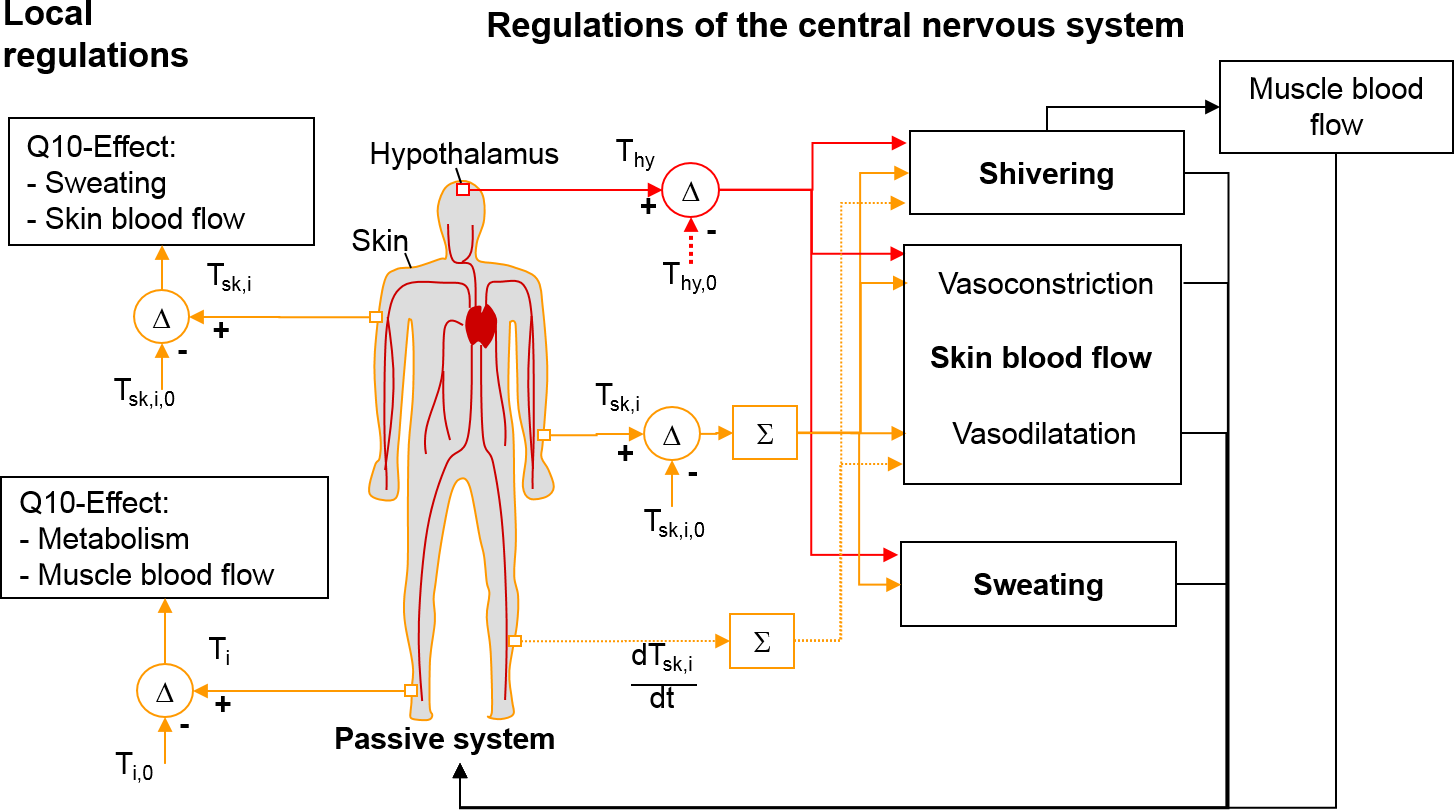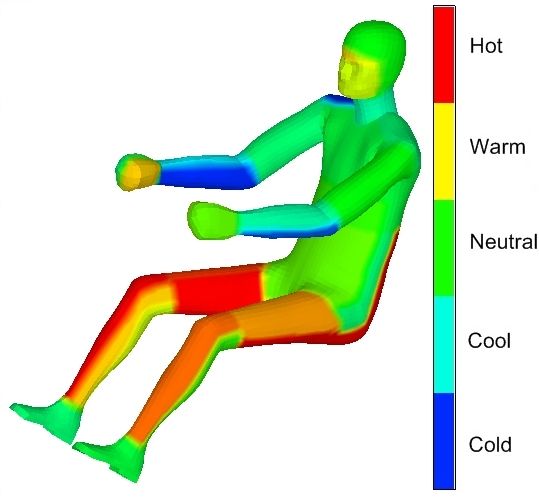Simulate and Evaluate Human Thermal Behavior.
Virtual human simulation model including all major thermal physiological effects.
Passive System
Basal human body physiology.
- heat conduction & sector-wise boundary conditions
- metabolic heat generation and blood circulation
- respiration and evaporation
- clothing / insulation layers
Active System
Body temperature regulation mechanisms.
- sweating / perspiration
- shivering
- vasomotion
Comfort Evaluation
Measuring human thermal comfort.
-
global comfort indices:
Fanger's PMV & PPD, Fiala's TS & DTS - Zhang's local comfort index
- equivalent temperature
Virtual Human Thermal Model FIALA-FE
Simulate human thermophysiological mechanisms and evaluate human thermal comfort.

FIALA-FE is a virtual computer model of the human body based on the latest research results in the area of thermophysiology for the simulation of human thermal responses and thermal comfort predictions. Realistic simulations can be performed taking into account aspects such as blood flow, breathing, evaporation, metabolic responses, sweating, shiver, cardiac output and the local heat exchange between the manikin and its environment. Insulation resulting from clothing can be assigned to each individual body part. The application possibilities of FIALA-FE greatly surpass the capabilities of physical manikins.
The thermal manikin FIALA-FE is fully integrated in our thermal analysis software THESEUS‑FE. It is a powerful tool providing both global and local thermal comfort indices, usable for tasks such as designing optimal HVAC control. When positioned in a vehicle cabin, the thermal manikin can be fully coupled with the surrounding environment. Convection, radiation and contact with the seat as well as evaporation, breathing and humidity are accounted for simultaneously.
The THESEUS‑FE package includes ready-to-use finite element models for a sedentary and standing postures, equipped with typical summer or winter clothing.
Common application areas for FIALA-FE are
- passenger comfort in cars, busses, trains and airplanes
- thermal environment evaluation in buidlings, e.g. office workspaces
Pennes Bioheat Equation
The core formula for simulating thermophysiology.

At the center of the mathematical model for FIALA-FE is the Bioheat Equation. This differential equation balances the internal energy of the passive system through heat transfer and heat storage, in other words metabolism and blood flow. Mathematically, the human organism is separated into two interacting systems: the controlling active system, and the controlled passive system. FIALA-FE combines both, passive and active systems, in a complex model. It reaches a good fit with real experimental results of human thermal responses using test subjects in a wide range of environmental conditions.
Passive and Active System
Thermophysiological mechanisms of inner-body heat production and regulation.

FIALA-FE combines both passive and active system in a complex model that reaches a good fit with experimental results. Blood flow through the arteries transports heat and causes a warming of the body. In cold environments the blood vessels contract (vasoconstriction), causing blood flow to be restricted or slowed, retaining body heat and increasing vascular resistance, thus causing less heat to reach the skin surface. In warmer environments blood vessels widen (vasodilatation). The flow of blood is increased due to a decrease in vascular resistance and more heat reaches the surface of the skin.
Passive System
The balance of heat of the human body is represented by
- a subdivision of the human body into body elements (spheres or cylinders), sectors and layers
- individual clothing layers per sector
- radial heat conduction simulated with a new finite element approach
- sector-wise boundary conditions: convection, radiation, evaporation and contact (e.g. to the car seat)
- metabolic heat generation: basal metabolism, working, shivering, Q10-effect, heating from arterial blood
- blood circulation solved simultaneously with additional degrees of freedom, the venous and arterial temperature per body element, as well as the blood pool temperature
Active System
Thermoregulatory responses of the active system that protect the core from extreme conditions are:
- vasoconstriction and vasodilatation: mechanisms that reduce or rise the blood flow through the skin
- shivering: internal heat generation in the muscle layers
- sweating: wetted skin leads to rising evaporative heat loss and cooling
These phenomena will be controlled by global state variables, which can be derived from the skin temperatures and the hypothalamus temperature.
Comfort Evaluation
Translate thermophysiological results into comfort sensation of actual people.

Thermal comfort models translate the physical description of the body thermal state into intuitive categories of cold, neutral or warm, comfortable or uncomfortable. Global models consider the complete thermal state, and local models hold for certain body parts, e.g. for the seat contact zone at the human back.
Global comfort indices
Global comfort indices aim at representing a person's overall comfort sensation as a single value. This one value can be taken as a general indication of the level of comfort under the given circumstances. Module FIALA-FE includes a large number of commonly used comfort indices and related quantities. These include
- Fanger's PMV (= predicted mean vote) and PPD (= percentage of persons dissatisfied)
- Fiala's TS (= thermal sensation) and DTS (= dynamic thermal sensation)
Local comfort indices
In contrast to the global ones, local comfort indices deliver insight into the comfort of individual body parts. They can be used to gauge the effect of localized heating/cooling of selected body parts on the overall state of comfort.
FIALA-FE includes the following models for local comfort evaluation:
- local comfort indices based on ISO14505-2 and ASHRAE 55 for summer and winter cases
- UC Berkeley comfort model ("Zhang's comfort model")
- local equivalent temperatures
Related publications available as free download

A computer model of human thermoregulation for a wide range of environmental conditions: the passive system
[english]
D. Fiala, K. J. Lomas, M. Stohrer
De Montfort University Leicester, University of Applied Sciences Stuttgart
Journal of Applied Physiology, 1999, Vol. 87, no. 5, pp. 1957-1972
Some Considerations on Global and Local Thermal Comfort based on Fiala's Thermal Manikin in THESEUS-FE
[english, 0.3 MB]
S. Paulke, S. Wagner
P+Z Engineering
6th EUROSIM Congress on Modelling and Simulation | September 9-13, 2007 | Ljubljana, Slovenia
Finite Element Based Implementation of Fiala's Thermal Manikin in THESEUS-FE
[english, 1.6 MB]
S. Paulke
P+Z Engineering
VTMS 8 (Vehicle Thermal Management Systems Conference and Exhibition) | May 20-24, 2007 | Nottingham, UK
Workshop: Thermal Manikin FIALA-FE (decoupled-modus)
[english, 5.8 MB]
S. Paulke
P+Z Engineering
Workshop @ DLR | July 28, 2011 | Göttingen, Germany
Individualisation of virtual thermal manikin models for predicting thermophysiological responses
[english, 0.2 MB]
D. Wölki, C. van Treeck, Y. Zhang, S. Stratbücker, S. R. Bolineni, A. Holm
Fraunhofer IBP
June, 2011






